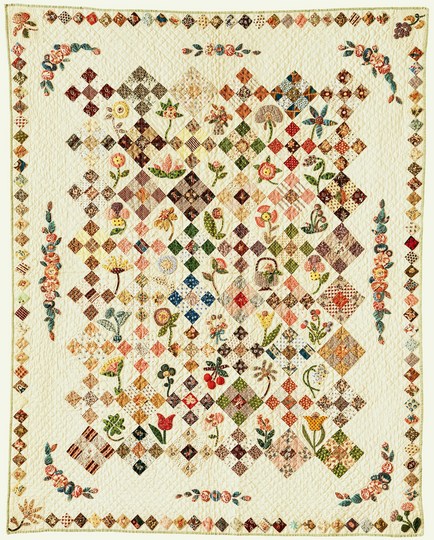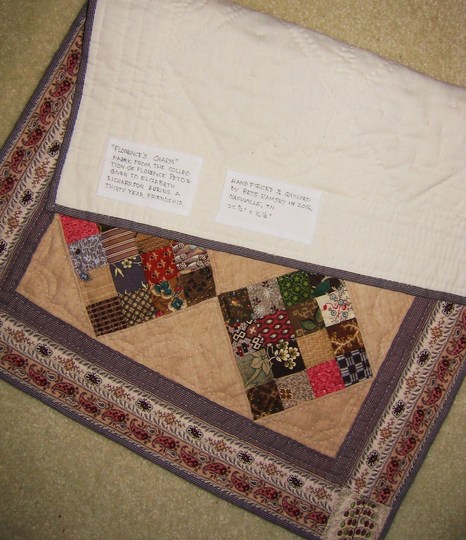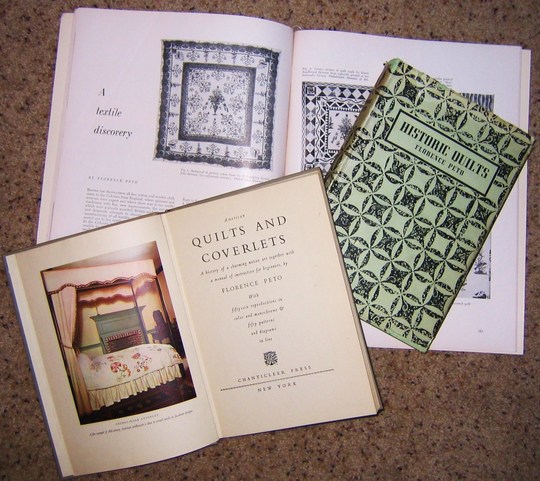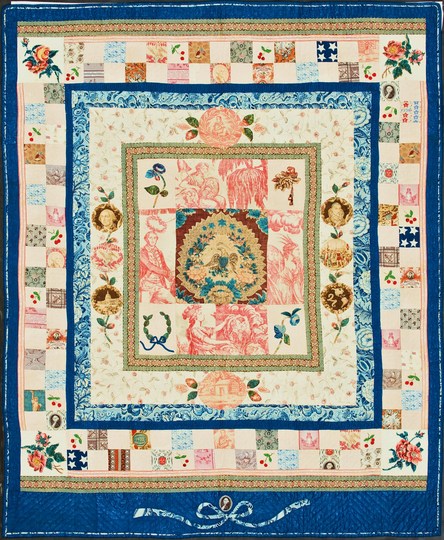The following is an excerpt from an article by Karen Alexander, Member of AQSG since 1981 and past President of The Quilters Hall of Fame, discussing quilting pioneer Florence Peto.

"Calico Garden Crib Quilt" (49" x 39") by Florence Peto,1950
Pieced appliqued and quilted cotton. (Shelburne Musuem permanent collection; photo courtesy Shelburn Museum)
Today it's hard to realize how little quilt history was available before the influence of our early 20th century pioneer quilt historians. Florence Peto is one of the most influential figures active before 1960. Peto wasn't alone in her pursuit of quilt history at that time. Marie Webster preceded her and Carrie Hall, Rose Kretsinger, Dr. William Dunton, Ruth Finley, and Berthe Stenge, just to name a few other TQHF Honorees were each busy in her/his own sphere. Each would eventually come in contact with Peto. Yet, Peto remains a unique voice in the quilt world from the 1930s-60s.
Taught by her New York Dutch grandmother to be a fine needlewoman at an early age, Florence Peto had a life-long interest in antique textiles in particular. Born in 1881 and married in 1900, her personal interest in textile research took on an added dimension as a result of her husband's position as a cotton converter and mill owner. Her access to his fabric sample books stirred her interest in dyes and printing methods, wetting her appetite for ever more knowledge. Her self-directed studies eventually led her to focus on quilts and for that the quilt world can be very grateful.

Photo by Karen Alexander
However, Peto didn't stop at just studying the fabric and pattern of the quilt. She went in search of the quilt's story. This is where the contacts she made through her lecturing often paid off. Peto believed that quilts were "cloth documents," and she wanted to know who, where, why and when about each quilt. Once she found a quilt, she interviewed family members and, when possible, sifted through archives, files, letters and even diaries to get the quilt maker's story. So great was her passion for these stories, her first book "Historic Quilts" (1939) focused on quilts for which she had personally gathered documentation.

Photo by Karen Alexander
Eventually becoming an excellent quilt maker herself and winning several contests, Peto's "Calico Garden" was selected in 1999 for inclusion in "The 20th Century's 100 Best American Quilts." Peto also wrote about quilts for the popular publications of the time — Antiques, American Home, Americana, Woman's Day, Hobbies and McCall's, lectured widely, designed needlework kits and greatly influenced the quilt collecting of several museums.

"Where Liberty Dwells" 1953 by Florence Peto. Private collection. (Photo courtesy Shelburn Museum)
Contemporary readers of the earliest quilt history books (such as Webster, Finley and Peto) will note that today's modern quilt historians have corrected some of the misnomers of these early historians. This in no way disparages their earlier work. We simply correct it and build upon it as new information is uncovered and new understanding develops.
Want to know more? Publications of both the American Quilt Study Group and The Quilters Hall of Fame offer more history on Florence Peto. This brief article is but a thumbnail sketch of a very talented productive woman. Surely Peto's life story presented in a full-length book with lots of photos is long overdue.
Avery, Virginia. "Florence Peto-Renaissance Woman of Mid Century," Quilter's Newsletter, January 1980.
Avery, Virginia. "Florence Peto, Path Finder," Ladies Circle Patchwork Quilts, Summer 1983: Carter Houck, Editor.
Clem, Deborah. "Florence Peto," The Quilters Hall of Fame, Rosalind Webster Perry and Merikay Waldvogel, Editors(1984),pg. 125.Gross, Joyce "Florence Peto and Woman's Day," Quilters' Journal, Mill Valley, CA, Vol. 3, No. 2.__________ "Florence Peto," Quilters' Journal, Mill Valley, CA: Winter 1979, Vol. 2, No. 4.
Peto, Florence "American Quilts and Coverlets New York": Chanticleer Press, 1949.
_______ "Historic Quilts New York:" The American Historical Company, Inc., 1939.
_______ "The Crib-Size Quilt". Woman's Day, December 1951, pg. 72-75, 125-127.
______ "A Textile Discovery". Antiques Magazine, 1953, pg. 120-121.
Florence Peto letter to Elizabeth Richardson, March 19, (1951?): courtesy of Bets Ramsey.
Woodard, Thomas K. And Blanche Greenstein. "Twentieth Century Quilts: 1900-1950" New York: E. P. Dutton and Company, 1988.




.jpg)


